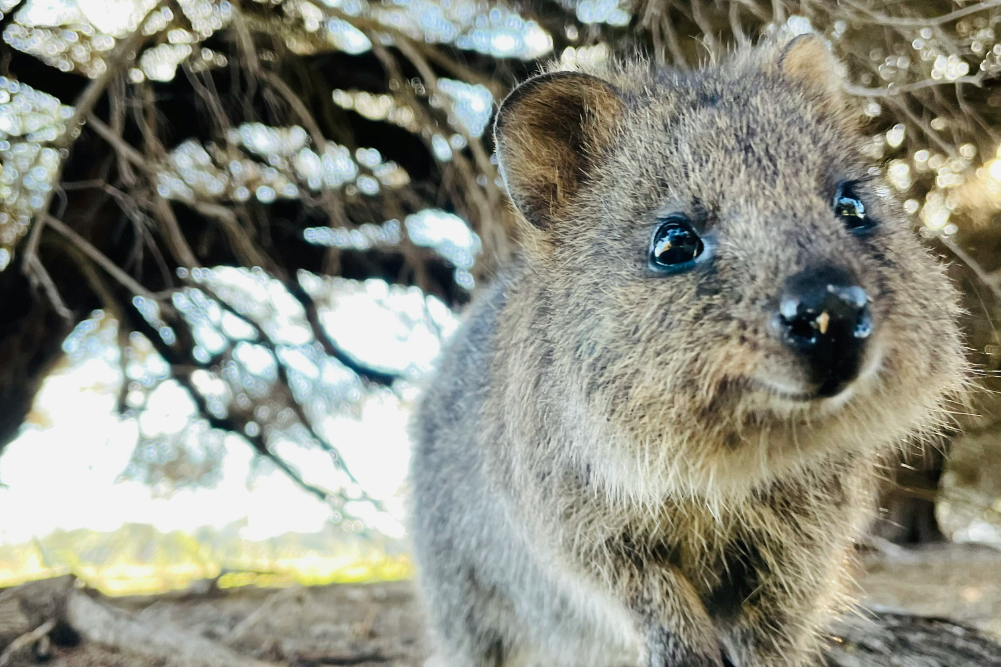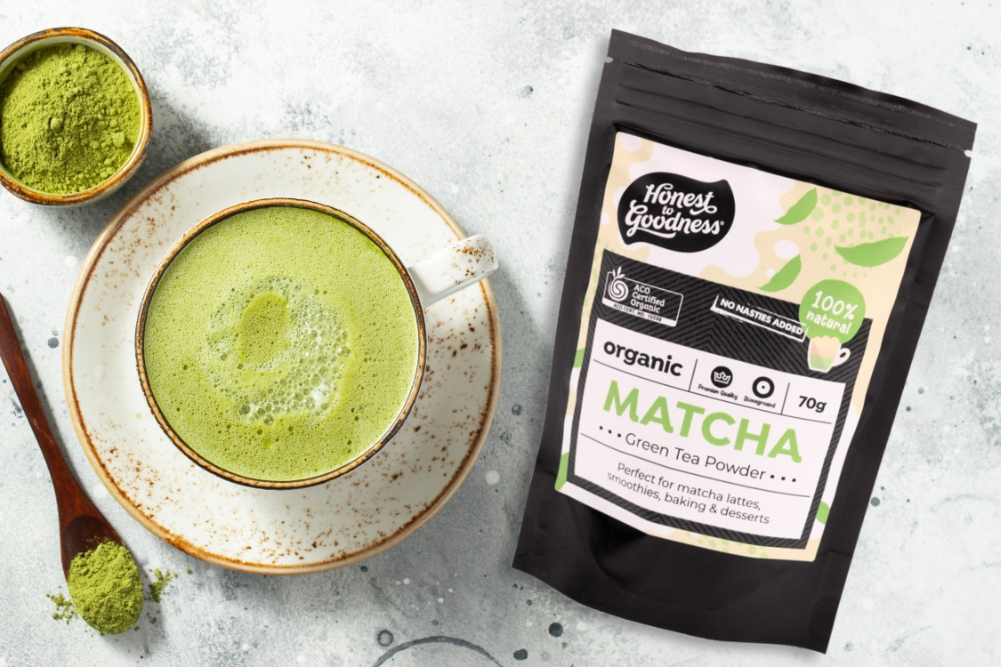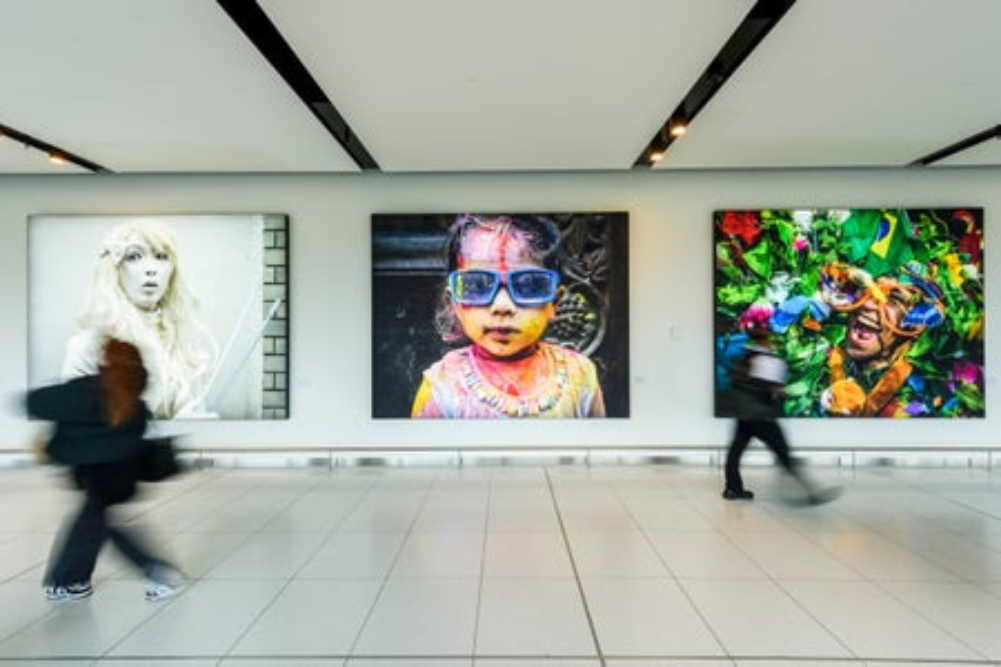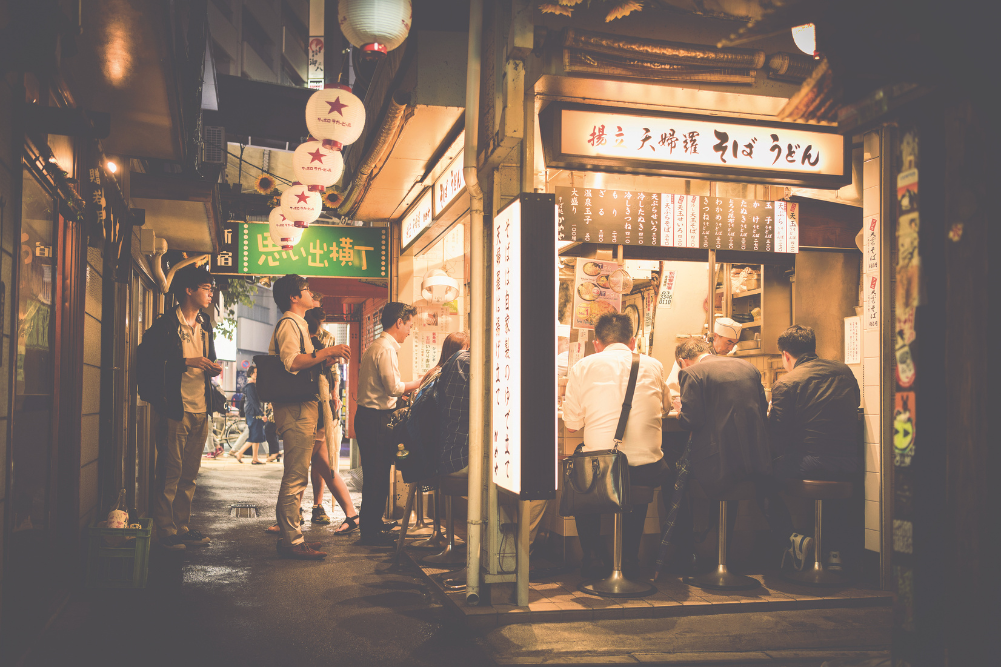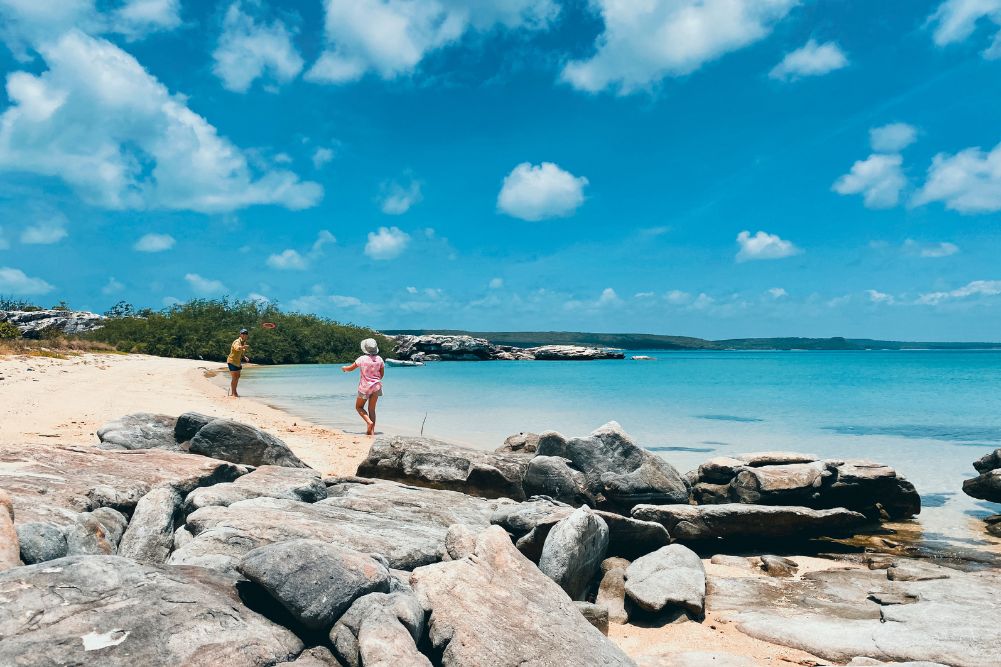Wandering Wild – Western Australia
I’m freewheeling high above the sea, cycling through blooming coastal heathlands and baking under a hot October sky. Far below floats a tri-coloured tapestry of baby-blue lagoons, rugged reefs and sailboats swinging at anchor in patches of bright white sand.
This summery seascape that flanks Perth’s most beloved island is utterly irresistible. So I park my bike, amble down over the cliff, strip off and fall right on in. I surface with a gasp that makes my daughter laugh, chilled by icy waters that flow straight out of Antarctica.
It might be breathtakingly cold, but the water clarity is insane. I stand waist-deep, watching my daughter duck and dive through schools of translucent fish while the dolphins that give Porpoise Bay its name hunt on the fringe. I might be anywhere on the blue-hued West Australian coastline, but only this one, picturesque island is monopolised by quokkas.
The Whadjuk Noongar people call it Wadjemup, meaning “place across the water where the spirits are”. But when Dutch explorer Willem de Vlamingh sailed by in 1696, he saw an island ruled by marsupials and called it Rotte Nest (or rat’s nest) for the quokkas and wallabies found in abundance.
Today, snapping a quokka selfie is de rigueur for Perth-bound travellers who cycle great distances for a head shot with a herbivorous, cat-sized quokka. Travelling Rottnest Island is now synonymous with these iconic creatures, and locals call it Rotto, the quokka’s stronghold, supporting two-thirds of the 15,000 creatures left in the world, all of them found only in WA’s southwest corner.
Tackling a big lap – Travelling to Rottnest Island
Located a 30-minute ferry ride from Fremantle Harbour, Rottnest is small as islands go, just 11km long and 4.5km at its widest point. In a leisurely day of cycling, you can just about see it all, detouring to the sea to discover snorkelling spots and surf breaks, reefs for fishing and diving, and lookouts that elevate you above vast inland salt lakes.
For those with more energy, there are lots of trails to hike too, and one tremendously sweaty climb to the Wadjemup Lighthouse for lofty vistas and much-needed coffee and snacks. We set out to tackle it all, hiring a trio of island bikes and helmets, and hitting the slow road in search of quokkas and serene sea views.
Rotto’s Visitor Hub: Where Adventure Meets Convenience
As wild as it all seems, Rotto caters for a constant, year-round stream of West Australian holidaymakers, with waterfront accommodation for all budgets, cafes and bars, gear rental and tour shops, all clustered together in the visitor hub known as The Settlement.
We cycle beyond the hubbub for brighter views, joining other cyclists shooting the breeze and pulling off the road wherever and whenever we please. The first stop is Parker Point to snorkel beneath rugged limestone cliffs, then a sandy detour to Salmon Bay to see if the surf break is working.
We push our bikes up the steep side road to Wadjemup Lighthouse for big-picture vistas that reveal an extraordinary sanctuary of salt lakes far below. Sea birds ride the thermals while we queue for coffee, then we snare a lucky seat in the shade to sip and dunk our cookies.
When I first discovered Rotto, the island’s roads were sleepy and the quokkas abundant. In the decades since, the pace (and the heat) has cranked up quite a bit, and with roads now abuzz with tour buses, I wonder where all the quokkas have gone?
Spotting quokkas
We leave the lighthouse behind us in a fun freewheeling descent, and suddenly turn a corner to find a crowd gathered roadside. At the centre of the scene crouches a tiny fawn-coloured quokka, grazing amid the selfie-seeking throng.
We watch awkwardly from the sidelines as the tourists chase their head shots, and the quokka patiently ignores its onlookers. It doesn’t appear to mind the limelight but its “vulnerable” status on the IUCN Red List of Threatened Species would suggest otherwise.
The Celebrity-Driven Quokka Phenomenon
In recent decades, the quokkas’ population has halved, challenged both on and off the island by habitat loss, rising global temperatures and increasing bouts of drought that diminish summertime water sources. Incongruously during this time, the quokka’s popularity has soared thanks to a growing pursuit of the celebrity-driven quokka selfie.
When the WA government paid tennis star Roger Federer to promote travelling to Rottnest Island, it’s said that his quokka selfie was seen by one in seven internet users. Visitor numbers rose and the fans kept on arriving, adding much-needed tourist levies to the slush fund dedicated to saving the quokka.
We leave the photo shoot behind and cycle on, past an endless stream of blue coves and white-sand beaches. Even without the allure of these enigmatic wild things, Rotto is worth every minute that I spend on the bike.
We crank uphill and hike to rugged limestone lookouts, to stand atop remnants of a fossilised coral reef. Across Narrow Neck and back again, the cerulean sea calls us, so we ditch the bikes and hit the sand to swim at Ricey Beach. Only when we finally complete our loop around the island do we encounter a pair of quokkas, scavenging on the outskirts of the settlement.
As mesmerising as they undoubtedly are, the backdrop is all wrong, so we haul back to the dock and make a beeline for the pub. We order icy brews and sit by the sea, but the quokka under the table is an unsettling juxtaposition. I feel like I’m sitting in his spot and, in many respects, I am, and these tourist-friendly conveniences have lured us both in.
The hard past
Before sea levels rose around 6500 years ago, Rottnest was connected to the Fremantle coastline, and was a place of ceremony and meeting for the Whadjuk Noongar peoples. Sealed off by the sea, the island was safeguarded for thousands of years but, ironically, the Whadjuk people returned as prisoners in 1838.
In the century that followed, 4000 Indigenous men and boys — children as young as eight and elders, leaders, warriors and lore men — were exiled on the island and held in a labour prison known as the Establishment.
As families dissolved on the mainland and cultural connections were lost, the prisoners endured grim lives marked by disease, constant cruelty and hard labour. So many Indigenous males died on Rotto that their unmarked graves now rate as Australia’s largest site of Aboriginal Deaths in Custody.
It’s very possible to visit Rottnest Island and know none of this story, despite its most handsome architecture being prisoner-built: the seawall, the original Wadjemup Lighthouse, the superintendent’s cottage and the old prison known as the Quod. When travelling Rottnest Island, it’s easy to miss the profound history beneath the island’s sunny, tourist-friendly facade.
Place of the woylie
The history that built Rottnest Island built nearby Fremantle too, so when our ferry docks back on the mainland, we decide to settle in and scratch the surface. Fremantle’s Noongar name “Walyalup” means “Place of the Woylie”, a critically endangered mammal once common in Fremantle. Today, Freo is wild in an entirely different way, loved for its food and music scene, markets, cafes and coffee.
We refill our mugs on the High Street and start our wander early, meandering through bewitching historical streetscapes with more spark than most. Everything is early 19th century, and these stone relics are revived as world-class museums, surf shops, wine bars and microbreweries.
Discovering Fremantle’s Unique Attractions
The WA Shipwreck Museum rates as the most renowned in the Southern Hemisphere, and its original restoration of the shipwrecked Batavia, using 400-year-old timbers unearthed from the seabed, is nothing short of spectacular. We stand inside a tiny prison cell in the 12-sided Round House — WA’s oldest public building — then incongruously wander next door to check out an ocean-themed art exhibition.
We take our appetites to the Fremantle Markets, shop for organic fare at Kakulas Sister and lose an hour at Three Stories, browsing surfboards, sustainable clothes and books worth buying. Outside, the streets are filled with art galleries, seriously good second-hand clothing stores and a head-swimming variety of coffee houses.
Finally, we settle in for fish and chips, digging our heels into the sand on Bathers Beach as the afternoon sea breeze — the Fremantle Doctor — blows our way. All of this exploring fills long happy days, and the money we save on so many free-to-enter museums and galleries gets spent on our gastronomic journeys.
Fremantle, and all that lies within reach of its turquoise coastline, remains a favourite place to spend time, regardless of how frequently I return. Steeped in history, much of it uncomfortable to uncover, it’s a place more vibrant, sustainable and forward-thinking than any I’ve found on the West Coast.
There’s a famous Indigenous Australian proverb that dwells with me when I travel. It’s a prescript for living life in general, but it resonates with me on this coastline: “We are all visitors to this time, this place. We are just passing through. Our purpose is to observe, to learn, to grow, to love … and then we return home.
Escape Routes – Travelling to Rottnest Island
Go
Ferries to Rottnest Island depart from Fremantle (25 mins, adults $84–$90 return), Hillarys Boat Harbour (45 mins, adults $90 return) and Perth (90 mins, adults $119–1$24 return, same day). All ferry operators offer free travel for kids under 12 years (conditions apply). Choose Sealink, Rottnest Fast Ferries or Rottnest Express.
Visit
Clear skies and sunshine make summer the best time for swimming off Rottnest Island and Fremantle, but peak-season pricing can double accommodation costs. Consider a less crowded, more affordable off-season stay during September/October or March/April.
Island Stay
On Rottnest Island, rooms at Samphire Rottnest start from $300/night (low season, samphirerottnest.com.au). Overlooking Pinky’s Beach, deluxe safari tents range from $580 to $1240/night (low/peak season, discoveryholidayparks.com.au). Budget options include campsites (from $43/night, low season), cabins (from $93/night) and hostel dorm rooms (from $65/night).
Fremantle Stay
Private rooms at the Fremantle Prison start from $174/night (yha.com.au), and there’s nothing like recycling an entire building to attract spectre-seeking guests. Purpose-built using sea containers and with its own brewery, the Hougoumont Hotel offers superior cabin rooms starting from around $233/night (hougoumonthotel.com).
Pack
Swimwear, snorkelling gear, clothes for cycling, reef-friendly sunscreen, a hat, refillable coffee mugs and water bottles (free drinking water stations are located around Rotto).
Rottnest Island Bike Hire
Daily bike and helmet hire costs $33 (adults), $23 (kids) and $11 to $21 for extras such as baby carriers, tagalongs or trailers.
More Information
Plan your travelling to Rottnest Island and book accommodation and tours at rottnestisland.com and visitfremantle.com.au
